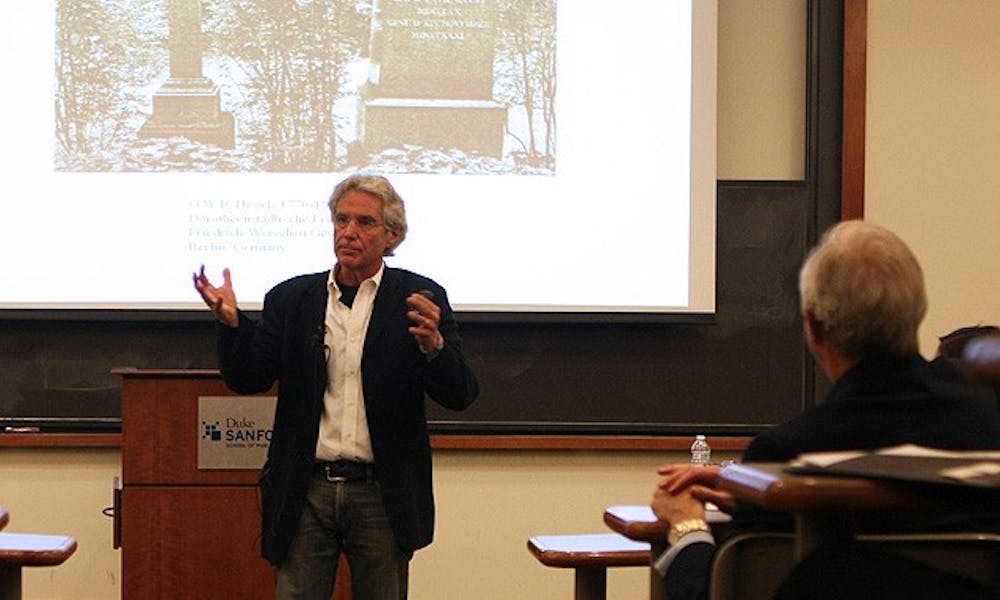The traditional university model may need more than a simple tune-up.
In the final part of the “Re-imagining the Academy” lecture series, Mark Taylor, education critic and chair of the department of religion at Columbia University, stressed the need to build collaboration, innovation and “networks” in higher education. Taylor’s speech Wednesday at the Sanford School of Public Policy was the fifth the lecture series has presented.
“Higher education in this country is in a state of crisis,” Taylor said in an interview with The Chronicle. He painted a bleak portrait of the state of American universities, emphasizing that they are unsustainable under the current model—“financially, curricularly and institutionally.”
Opening his discussion by contextualizing higher education “historically, philosophically, socially, politically [and] economically,” Taylor went on to explain why the current university structure is outdated and in need of fundamental reform. He described philosopher Immanuel Kant’s university blueprint in the 18th century, drawing parallels between his proposals for peer review, specialization and departmental autonomy and current university policies.
Despite these historic roots, Taylor said he did not believe the way we currently organize knowledge is “hard-wired.” Instead, he expressed the need to realign educational organizations with modern demands and infrastructure changes.
“In the past 40 years, we have moved from an industrial model to a ‘network world’ that doesn’t operate that way,” Taylor said in an interview. He added that “we have to find better ways of understanding in this changing infrastructure” to better serve students and the greater community.
In order to achieve these goals, Taylor called for greater focus on undergraduate teaching, increased use of technology in the classroom—especially teleconferencing among universities—and more interdisciplinary, problem-oriented initiatives.
By these metrics, Duke appears to be headed in the right direction. Audience member Lee Baker, dean of academic affairs of Trinity College, said in an interview after the speech that Duke’s certificate programs are models for problem-based learning.
“Duke is already leading in some of these areas, especially in our collaboration with [the University of North Carolina at Chapel Hill] and also internationally,” he added.
Taylor acknowledged that Duke’s initiatives are a start, but stressed that the changes must be “much larger.” He expects successful reform will have to be systemic and extensive, spanning entire departments and institutions.
“Institutions are acting independently of each other—they have to cooperate instead of just compete,” Taylor said in an interview. “Only if a group of leading universities get together to discuss the issues and proposals might we see a change.”
Meanwhile, many educators consider Taylor’s proposals to be quite radical, especially his call to end tenure and institute a mandatory retirement age for professors. In the past, his efforts to push through his reforms have been met with resistance from colleagues. In the 1990s, he founded the Global Education Network to bring high-quality technology to humanities, arts and sciences classrooms but was turned down by all but one university, including Duke.
Taylor himself expresses little optimism for his proposals and the future of higher education. He privately said the probability of changes happening is “nil,” citing a base of “self indulgent” teachers, a “mania about ratings” among elite institutions and an insistence on outdated forms of literature such as dissertations, for which there is no longer a demand.
He expressed particular frustration with the internal politics of faculty promotion in universities, particularly research institutions, which he believes “[measure] prestige in how little you teach.”
The imbalance between research and undergraduate teaching is only one of many overlooked failures within higher education, Taylor said, noting that only 15 to 18 percent of postsecondary students are in the 18 to 22-year-old age range, while the vast majority are “nontraditional” students who participate in continuing learning, often online. Taylor emphasized this statistic to show that our current conception of higher education as concentrated in a few elite universities is outdated, and he added that schools like Duke must reevaluate their role in the greater academic community.
“We have to think systemically about how to cooperate with schools that are less fortunate,” he said. He added that he worries about the inequitable distribution of wealth within institutions of higher education, noting the massive budget cuts in the California and Pennsylvania state school systems.
“For those of us at elite institutions, it may not look like the sky is falling,” Taylor said. “But for many institutions, it is.”
Donna Lisker, associate dean for undergraduate education who helped bring Taylor to campus, said his remarks were instrumental for “helping us broaden our view... in thinking of education as a whole.”
“We’re certainly thinking about innovation in education,” Lisker said. “Whether we’d use this blueprint or one of our own, it’s hard to say.”
Get The Chronicle straight to your inbox
Signup for our weekly newsletter. Cancel at any time.

